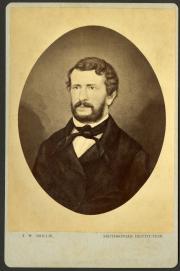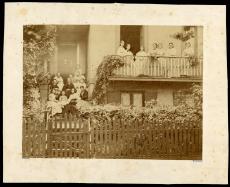Throughout March, we will be celebrating Women's History Month with photos in the Flickr Commons and a series of blog posts about women from the Archives' collections.


 Family connections were one of the ways women were able to enter professional positions in the 19th century, and Jane Turner is a great example of that pattern. She was appointed a library clerk in 1858, and after her brother's early death in 1859, was placed in charge of the library. Secretary Joseph Henry wrote of her that she "vindicates by her accuracy and efficiency the propriety of employing her sex in some of the departments of the government."
Family connections were one of the ways women were able to enter professional positions in the 19th century, and Jane Turner is a great example of that pattern. She was appointed a library clerk in 1858, and after her brother's early death in 1859, was placed in charge of the library. Secretary Joseph Henry wrote of her that she "vindicates by her accuracy and efficiency the propriety of employing her sex in some of the departments of the government."
 After a devasting fire in the Smithsonian Castle in 1865, Henry transferred the Smithsonian Library to the Library of Congress in 1866. Jane Turner then served as assistant to A. R. Spofford, Librarian of Congress. She also was clerk in charge of the Smithsonian’s International Exchange Service from 1866 to 1869. Turner oversaw the distribution and exchange of scientific publications with 1,744 institutions in twenty-six countries. Turner's position, however, did not entail supervising men. When the Institution recruited another person to handle the ever growing International Exchange Service in 1885, one Smithsonian administrator wrote: "I have a full appreciation of the merits, business capacity, and efficiency of women, as is shown by the fact that our present librarian is a 'female of that sex'; but the place I refer to may grow to be a controlling one, covering several extensive departments which could not well be subordinated to a woman." The glass ceiling was cleary put up early in Smithsonian history.
After a devasting fire in the Smithsonian Castle in 1865, Henry transferred the Smithsonian Library to the Library of Congress in 1866. Jane Turner then served as assistant to A. R. Spofford, Librarian of Congress. She also was clerk in charge of the Smithsonian’s International Exchange Service from 1866 to 1869. Turner oversaw the distribution and exchange of scientific publications with 1,744 institutions in twenty-six countries. Turner's position, however, did not entail supervising men. When the Institution recruited another person to handle the ever growing International Exchange Service in 1885, one Smithsonian administrator wrote: "I have a full appreciation of the merits, business capacity, and efficiency of women, as is shown by the fact that our present librarian is a 'female of that sex'; but the place I refer to may grow to be a controlling one, covering several extensive departments which could not well be subordinated to a woman." The glass ceiling was cleary put up early in Smithsonian history.
After Henry’s death in 1878, the Institution's library began to grow again and Ms. Turner resumed the duties of Smithsonian Librarian in 1882 until 1887 when she resigned after a reorganization of the Library by the new Secretary, Samuel P. Langley. After Turner's retirement, a woman was not appointed Chief of the Smithsonian Library until 1942, during World War II, when Leila Gay Forbes Clark was placed in charge.
Related Collections
- Record Unit 7098 - Biographical Information File, Smithsonian Institution Archives
Related Resources
- In Memoriam - Jane Wadden Turner, Open Library
- Smithsonian Institution Libraries history, Smithsonian Institution Archives
Produced by the Smithsonian Institution Archives. For copyright questions, please see the Terms of Use.

Leave a Comment